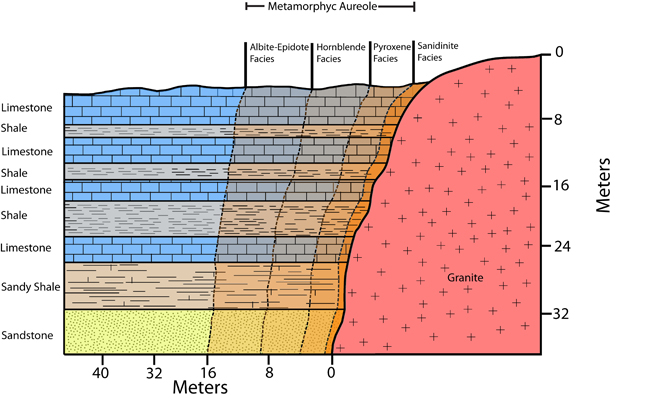Albite-Epidote-Hornfels
The first mention of contact metamorphic phenomena dates back to the end of eighteenth century when James Hutton observed that, the rocks surrounding a granitic body at Glen Tilt (Perthshire, Scotland) had suffered marked changes in either colour or structure especially in zones crossed by granitic veins. At that time Neptunists and Plutonists were still debating the sedimentary vs igneous origin of granitic rocks, and the terms "metamorphism" and "contact metamorphism" had still to enter the geological vocabulary.In the first decades of the nineteenth century rock alterations close to contacts with granitic rocks were increasingly discovered in other localities of England and Scotland as well as in other European countries. They were observed in a variety of settings (plutonic and volcanic) involving a wide spectrum of rock types. Many names appeared for this particular and localised type of metamorphism and its varietie. Delesse (1857) proposed the term contact metamorphism which found general acceptance and is still widely used today.
Therefore to avoid any further ambiguity the SCMR proposes that the term ‘thermal metamorphism’ is no longer accepted as a recommended synonym of "contact metamorphism" and should be given restricted status. The recommended definition of contact metamorphism is, therefore, as follows:
Contact metamorphism: Type of metamorphism of local extent that affects the country rocks around magma bodies emplaced in a variety of environments from volcanic to upper mantle depths, in both continental and oceanic settings.
The zone where contact metamorphism occurs (Fig.1) is called the contact aureole, while the products of such metamorphism are called contact rocks. The thickness of the aureole ranges from the millimetre- to the kilometre-scale. The intensity of contact metamorphism decreases from the innermost to the outermost parts of the aureole.

Fig.1: Contact aureole and hornfels Facies.
Hornfels
Today this name is widely used for a group of compact, highly metamorphosed contact rocks, typically found in inner aureoles. It derives from an ancient term used by miners in Saxony (Germany) for hard compact rocks of various origins, characterised by their horny appearance and conchoidal to subconchoidal fracture, and commonly associated in the field with granitic rocks (Leonhard, 1823). Different definitions of hornfels have appeared with varying emphasis placed on compositional and structural features. For some, hornfels is an aluminous rock derived, for example, from shale; for others it also includes quartzofeldspathic protoliths such as graywackes and for some the term can be applied to any contact-metamorphic rock (including calc-silicate hornfels, quartz-hornfels, mafic and ultramafic hornfelses) provided they possess the distinctive structural characters recognised by the old Saxon miners. Another controversial point concerns the grain size of a hornfels; to some (especially those supporters of an aluminous character of the hornfels) it is very fine- to fine-grained; others regard it as very fine to coarse.To resolve these problems the SG decided that the name "hornfels" should only be used for contact metamorphic rocks dominantly composed of silicate + oxide minerals in varying proportions. Contact marble and coal are considered as separate rock types:
A hard, compact contact-metamorphic rock of any grain size, dominantly composed of silicate + oxide minerals in varying proportions, with a horny aspect and a subconchoidal to jagged fracture. The typical mineralogy of hornfels with different protoliths varies with metamorphic facies.
Hornfels are split into:
(1) albite-epidote-hornfels facies,
(2) hornblende-hornfels facies,
(3) pyroxene-hornfels facies,
(4) sanidinite facies.
the rock in question is a "Spotted rocks": Spotted slate are chemically equivalent to Hornfels but appear in the outer parts of contact aureoles developed in slate and phyllites. The rocks have spotted ore maculated texture; in the lowest-grade rocks the spots are clots of minute graphite, magnetite and sericite. In slightly higher-grade types micas, especially biotite may appear in coarser flackes; in some type andalusite ore cordierite forms small but distinct porphyroblasts.
Bibliography
• David Shelley (1983): Igneous and metamorphic rocks under the microscope. Campman & Hall editori.
• E. WM. Heinrich (1956): Microscopic Petrografy. Mcgraw-hill book company,inc
• Anthony R. Phillpotts & Jay J. Ague: Principles of igneous and metamorphic petrology. Cambridge editore.
• Passchier, Cees W., Trouw, Rudolph A. J: Microtectonics (2005)


.jpg)
.jpg)
.jpg)
.jpg)
.jpg)
.jpg)
.jpg)

.jpg)
.jpg)
.jpg)
.jpg)
.jpg)
.jpg)
.jpg)
.jpg)
.jpg)
.jpg)
.jpg)
.jpg)
.jpg)
.jpg)
.jpg)
.jpg)
.jpg)
.jpg)
.jpg)
.jpg)

.jpg)
.jpg)
.jpg)
.jpg)
.jpg)
.jpg)
.jpg)
.jpg)
.jpg)